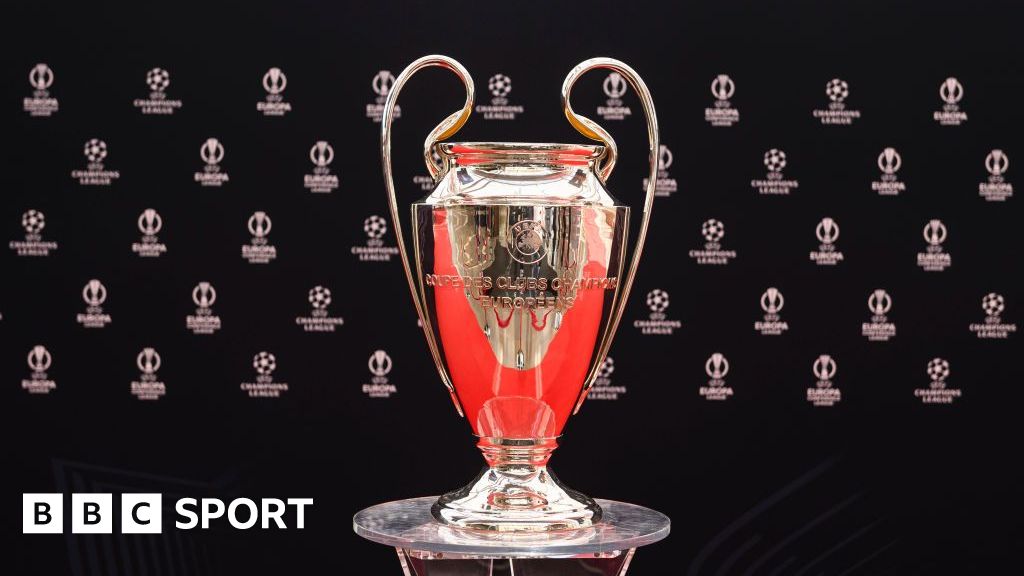Image source, Getty Images
- Author, Charlotte Coates
- Role, BBC Sport journalist
-
Football is always evolving and Europe’s most prestigious competition, the Champions League, is no different.
From next season, a new format will be in play after Uefa approved the changes in May 2022.
It is the first time since 1992 that Europe’s elite competition has seen such a revamp.
Uefa president Aleksander Ceferin said qualification will be “based on sporting merit”.
What is the new Champions League format and how does it work?
The Champions League group stage is currently set up with 32 teams in eight groups of four – with the top two sides from those groups qualifying for the last 16.
However, this format will be replaced by one league table where 36 clubs will participate in the new league phase – giving four more sides the chance to compete.
Clubs will no longer play three teams twice, but will take on eight different sides with four home games and four away games.
To determine fixtures, the teams will be ranked in four seeding pots and each team will then be drawn to play two opponents from each of these pots.
They will play one match against a team from each pot at home, and one away.
How will the knockout stages work?
Teams who finish in the top eight will qualify automatically for the last 16, while those who place ninth to 24th will compete in a two-legged knockout play-off for the chance to join them.
Whoever finishes 25th or lower will be eliminated and will not be entered into the Europa League.
From the last 16 onwards, the Champions League will continue to follow its existing format with the final taking place at a neutral venue.
How many more games will be played and when will they be played?
The number of matches in the new format will increase from 125 to 189.
Each team will play a minimum of eight – instead of six – and a maximum of 17.
In standard weeks, Champions League matches will still be played on Tuesdays and Wednesdays.
In the Champions League exclusive weeks – when no other European competitions are played – games will be played across Tuesday, Wednesday and Thursday.
The league phase will now end at the end of January instead of during December.
How many Premier League teams will be in Champions League?
For Premier League clubs, the situation is now clear. The top four go into the Champions League with the fifth-placed team going into the Europa League.
This means Man City, Arsenal, Liverpool and Aston Villa will be in the elite club knockout competition next season.
Fifth-placed Tottenham will have to settle for the Europa League, along with FA Cup winners Manchester United. Chelsea will be in the Conference League.
How do the coefficient places work?
Germany and Italy are the nations to have secured a fifth automatic spot in next season’s tournament.
The coefficient places, otherwise known as ‘European Performance Spots’, go to the associations who have the best collective performance by their clubs in the previous season.
Italy will have five representatives in Europe’s premier competition after Atalanta won the Europa League.
The Bundesliga could even have six spots if Dortmund win the Champions League having finished outside the top four in the Bundesliga.
The winners of both tournaments qualify automatically for the following season’s Champions League.
Who has qualified for Champions League group stages?
England: Man City, Arsenal, Liverpool, Aston Villa
Spain: Real Madrid, Barcelona, Girona, Atletico Madrid
Italy: Inter Milan, AC Milan, Juventus, Atalanta, Bologna
Germany: Bayer Leverkusen, Stuttgart, Bayern Munich, RB Leipzig, Borussia Dormund
France: Paris St-Germain, Monaco, Brest
Netherlands: PSV Eindhoven, Feyenoord
Portugal: Sporting Lisbon, Benfica
Ukraine: Shakhtar Donetsk
Two further places will be filled by the European Performance Spots, while the final seven slots are determined via qualifying.
How has the Champions League format changed over the years?
Europe’s most notable football competition began during the 1955-56 season as only a six-team invitational tournament, initially known as the European Champion Clubs’ Cup.
From 1967, the competition grew to 32 teams, was called the European Cup and featured four two-legged rounds prior to a single-match final – this model would last for more than 20 years.
The Champions League as we know it began in 1992.
A group stage was added with the last 16 entering a knockout phase.
There was a brief spell with two group stages, but this was reverted back to the single group-stage format for the 2003-04 tournament.
Are the Europa League and Europa Conference League going to change too?
Yes. Both competitions will see similar changes to those of the Champions League.
The Europa League will follow the same format as the Champions League from next season.
Europe’s third-tier competition, the Europa Conference League, will be rebranded as the Uefa Conference League and teams will play six matches against six different opponents in the league phase.
Both the Europa League and Uefa Conference League will also feature 36 teams.

